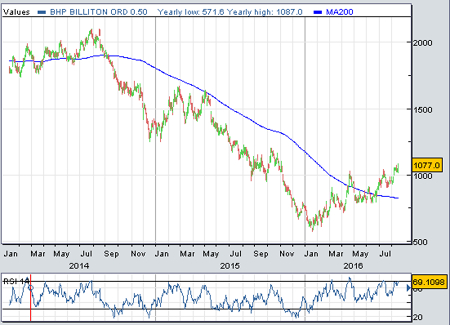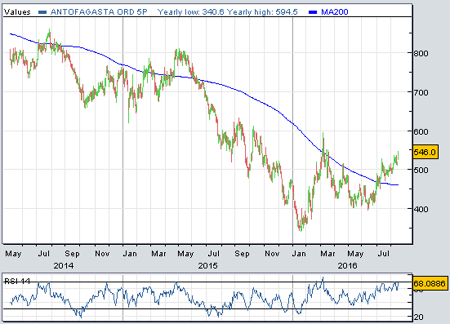BHP Billiton and Antofagasta both winners
16th August 2016 15:00
With expectations low, it didn't take much for to "impress" the market - if you can call it that. A weak top line and colossal impairment caused a record loss, yet the mining giant's share price is up at a nine-month high. Elsewhere, it's clear to see why has rallied. Despite first-half figures hit by a limp copper market, the Chilean miner predicts an end to market oversupply by 2018.
Weak commodity prices caused revenue at BHP to crash over 30% to $30.9 billion in the year to 30 June, with cash profit down 44% to $12.3 billion (£9.5 billion). However, this was still about 4% ahead of consensus estimates. Iron ore's importance in the mix increased, too, contributing 45% of group profit, up from 40% last year. That's good news, with Chinese imports pushing the price to a three-month high.
Following the death of 19 people and the destruction of two towns following the tragic Samarco dam failure last November, BHP is "fully committed" to the Framework Agreement compensation programme, which has so far cost the group $2.2 billion. Operations are unlikely to begin again this year, and findings from an external investigation will be available in "the next few weeks".

With $7.7 billion of one-off items, including $4.9 billion of impairments against its US oil division, BHP swung from an $8.7 billion operating profit to $6.2 billion loss. Underlying profits of $1.2 billion just beat expectations.
Lower operating costs, investment flexibility and a reduction in capital expenditure to $6.9 billion meant free cash flow reached $3.4 billion. After achieving $437 million of cost savings in 2016, BHP is targeting $2.2 billion by the end of 2017, when the capital expenditure budget will shrink again to $4.6 billion.
Encouragingly, another US$1.8 billion of anticipated productivity gains next year should help deliver more than $7 billion of free cash flow.
As promised, the miner's full-year dividend is slashed by three-quarters to 30 cents per share, with a final payout of 14 cents down 13%, giving a 2.2% yield.
Back to the high life
Of course, BHP is confident commodities will enjoy the high life once again, although investors will suffer volatility for some time to come - that's why it's so focussed on cutting costs. BHP also has significant oil and gas interests and has been expanding its US shale business, although this was the business rocked by a $4.9 billion impairment in 2016.
"The last 12 months have been challenging for both BHP Billiton and the resources industry," said chief executive Andrew Mackenzie. "Nevertheless, our results demonstrate the resilience of our portfolio and the diverse ways in which we can create value for shareholders despite low commodity prices."
Alongside Antofagasta, BHP's share price increased Tuesday, limiting the FTSE 100's decline from recent highs. Jumping 4% to a nine-month best of 1,079p, BHP continues to claw back the losses triggered by fears of China's weakening economy and the commodity price slump, although there is still a long way to go.
As part of their cyclical nature, BHP and Antofagasta tend to mirror each other's share price performance. BHP Billiton has now surged 88% from its February low and Antofagasta 60% to a five-month high of 547p, valuing the firms at £22.7 billion and £5.4 billion respectively.

It was first-half results that triggered Antofagasta's 6% surge on Tuesday after management confirmed higher production guidance, the continued ramp up of its Antucoya project and hinted at an end to oversupply by 2018.
Lower copper prices and sales volumes pulled Antofagasta's revenue down 18% to $1.4 billion in the six months - the closure of sulphide and oxide deposit Michlilla in 2015 didn't help. Tighter control on operating costs and maiden contributions from its 50%-owned Zaldivar mine boosted cash profit 2.3% to $571.6 million, however, strengthening its margin 800 basis points to 39.5%.
Antofagasta's output will be weighted to the second half and at the lower end of guidance Strip out the contribution from depreciation and amortisation of assets and operating profit fell 9%, with earnings per share slipping 3% to 8.9 cents. Sticking to its 35% of net earnings pay-out policy, an interim dividend of 3.1 cents per share is flat on last year.
Volatility could still rock the copper market amid national stimulus programmes, macroeconomic events and US dollar movements, although there have already been some cuts to mine production. More can be expected if prices weaken to $2/lb, but supply surpluses are expected until 2018, when the market should swing into deficit.
Antofagasta's operating costs fell by $124 million and spend on capital investment shrunk 42% to $385 million - the full-year budget will now be lower than first thought. Strength of the balance sheet is a key priority of new boss Diego Hernández, who has led an aggressive cost-cutting programme since being promoted to the helm in April. Net debt stayed relatively flat at around $1 billion.
Copper production came in 6.6% higher than this time last year at 323,300 tonnes, as new production from Antucoya and Zaldivar offset the Michilla closure and lower production at Centinela. With expansions and Centinela and Antucoya, Antofagasta's output will be weighted to the second half of the year, although it will be at the lower end of the 710-740,000 tonnes guidance issued in January.
"This bodes well for 600p to be revisited even if the copper price itself remains trapped within a narrowing trend of rising lows and falling highs going back to last year," says head of research at Accendo Markets, Mike van Dulken.
This article is for information and discussion purposes only and does not form a recommendation to invest or otherwise. The value of an investment may fall. The investments referred to in this article may not be suitable for all investors, and if in doubt, an investor should seek advice from a qualified investment adviser.
Editor's Picks